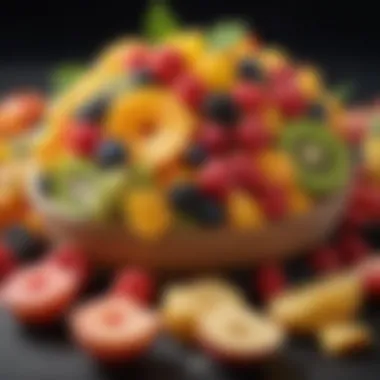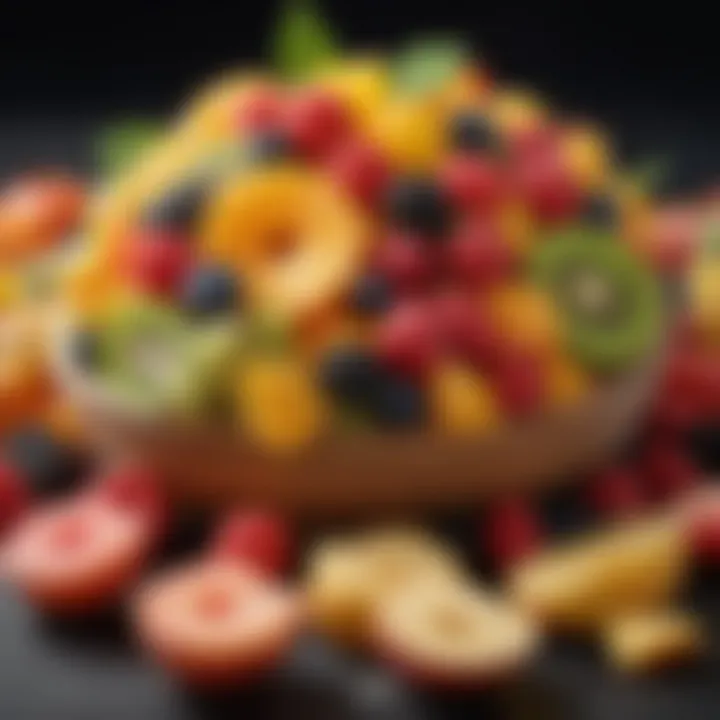Healthy Snacks Without Salt: Your Complete Guide


Intro
In a world where snacking has become synonymous with indulgence, the shift towards healthier options is gaining momentum. Salt-free snacks are carving a niche for themselves, marrying health benefits with flavorful experiences that many may not expect. This exploration into the realm of salt-free snacking seeks to unveil how one can munch without the excess sodium, while still enjoying a burst of taste.
Many individuals are becoming more conscious about their dietary choices, aiming to reduce sodium intake for heart health or other reasons. A diet low in salt can lead to numerous health advantages, including lower blood pressure and reduced risk of stroke. Yet, the challenge lies in finding replacements that don't skimp on flavor or satisfaction.
This guide will provide an extensive look at various salt-free snacks, presenting recipes that you can easily whip up at home. With an emphasis on ingredients, preparation methods, and creativity, our aim is to support a diverse array of dietary preferences, offering something for everyone—from the gluten-free to the vegan.
Diving into this culinary adventure not only embraces health but also indulges the palate. Flavor need not suffer in the absence of salt; with thoughtful ingredient choices and innovative recipes, one can achieve both healthfulness and deliciousness. So, buckle up as we make our way through the savory landscapes of salt-free snacking.
Understanding the Importance of Healthy Snacks
Healthy snacking is more relevant now than ever before. With the fast-paced lifestyle many lead today, making informed choices about what to munch on can have a significant impact on overall well-being. Snacks often fill the gaps between meals, offering a chance to meet dietary goals while satisfying cravings. Moreover, when chosen wisely, snacks can be nutrient-dense bites that enhance one's diet rather than detract from it.
Defining Healthy Snacking
At its core, healthy snacking revolves around selecting foods that provide nutritional benefits without unnecessary additives, particularly excess sodium. But what does "healthy" really mean in the context of snacks?
When we talk about healthy snacks, we refer to items rich in vitamins, minerals, and fiber. These include options like fruits such as apples and bananas, vegetables like carrots and bell peppers, and whole grains including oats and quinoa. A snack isn't just something you shove in your mouth to stave off hunger; it can act as an opportunity to boost your nutrient intake, regulate blood sugar levels, and even control weight.
A healthy snack should ideally have a balance of macronutrients—protein, fats, and carbohydrates. For example, a handful of almonds combines healthy fats with protein, while a piece of fruit provides carbs along with essential vitamins. By definition, healthy snacking is about making choices that serve your body well, instead of just satisfying your immediate cravings.
The Role of Snacks in Nutrition
Snacks hold a pivotal role within the broader scope of nutrition. They serve as mini-meals, often acting as a bridge between breakfast, lunch, and dinner. Without proper snacks, someone might find themselves reaching for whatever is around, which could lead to poor food choices. Having planned snacks can help prevent the dire outcomes of hunger pangs, where one might be tempted to indulge in less healthy options, hence often leading to excessive calorie intake.
Moreover, incorporating snacks into the diet can significantly enhance the nutritional intake for individuals, especially those with specific dietary requirements. For * athletes,* for instance, the right snacks can support energy levels and recovery post-exercise. On the flip side, those looking to manage their weight can benefit from guilt-free, nutritious snacks that mitigate the likelihood of overeating at mealtimes.
In summary, embracing healthy snacking requires altering perceptions from mere munching to a mindful practice that complements and nourishes our dietary habits. As we explore the vast world of salt-free snacks, the key is to remember that every bite counts, making the journey toward healthier choices worthwhile.
The Impact of Excess Sodium
Sodium, while essential for bodily functions, has gained a notorious reputation due to its prominence in modern diets—especially through processed foods and snacks. Understanding the impact of excess sodium is crucial for anyone looking to maintain their health. High sodium levels can lead to various health concerns, creating a ripple effect that affects everything from heart health to kidney function. As this article pivots towards salt-free snacks, it's paramount to emphasize the adverse outcomes associated with excessive sodium intake, as well as the sources that contribute to this issue.
Health Risks Associated with High Sodium Intake
Several health risks are closely linked to high sodium intake. Elevated sodium levels can lead to increased blood pressure, a major risk factor for cardiovascular diseases. With the heart working overtime to manage the extra sodium in the bloodstream, the wear and tear can result in serious repercussions, such as heart attacks or strokes. But that's not all; high sodium can also lead to conditions like hypertension, which affects millions worldwide without them even knowing.
Moreover, excessive sodium consumption can put a strain on your kidneys. When your body processes too much salt, the kidneys have to work harder to filter it out, which can lead to decreased kidney function over time. This can exacerbate existing kidney issues, leading to further complications.
But let's not forget about bone health. Several studies suggest that high sodium diets can lead to calcium loss, potentially increasing the risk of osteoporosis. As we age, maintaining strong bones becomes even more critical, making it vital to keep an eye on that salt shaker.
Understanding Sodium Sources in Snacks
When it comes to snacks, many might not realize just how much sodium sneaks into their diets through seemingly innocent options. Snacks vary widely, but some common culprits include:
- Processed Chips and Crackers: These savory delights often pack more sodium than one might expect.
- Canned Foods: Items like soups and vegetables can be high in sodium, even if they seem healthy at first glance.
- Cheese and Dairy Products: While nutritious, many varieties are laden with salt.
- Pre-packaged Snack Foods: These can be a minefield, as manufacturers often add significant sodium for flavor preservation.
The problem is compounded by the fact that salt is often not the only source of sodium in snacks. Ingredients like baking soda, monosodium glutamate (MSG), and various preservatives contribute substantial amounts.
Understanding the various sources of sodium in your diet is the first step towards an informed approach to healthier snacking.
Being aware of where sodium hides can empower readers to make better choices, steering away from high-sodium products and seeking out healthier, salt-free options. In this journey, recognizing that snacks can indeed be both delicious and nutritious, without the added sodium, is a perspective shift worth exploring.
Exploring Salt-Free Snack Options
In the pursuit of healthier eating habits, embracing salt-free snack options is a wise choice. By delving into salt-free alternatives, not only do you mitigate health risks associated with high sodium intake, but you also open yourself up to a vibrant world of flavors and textures that fruits, vegetables, whole grains, and nuts offer. The charm of exploring these snacks lies in their versatility; they can be enjoyed by anyone, regardless of dietary preferences. Thus, distinguishing between various snack options allows individuals to customize their diets and experience nutrition in a delightful manner.
This section emphasizes the significance of incorporating diverse salt-free snacks into daily life, aiming to inspire readers to make informed choices while enjoying delectable flavors. Now, let’s explore the first category of snacks that naturally thrive without salt.
Fruits and Vegetables as Snacks
Packed with vitamins, minerals, and fiber, fruits and vegetables serve as some of the most exciting snack options that require no introduction to salt. The beauty of these snacks is their inherent sweetness or savoriness that can stand on their own. For instance, snacking on carrot or cucumber sticks provides a hydrating crunch that satisfies in both texture and taste. Meanwhile, a juicy apple or a handful of sweet strawberries offers that instant energy boost when mid-afternoon fatigue hits.
- Versatility: You can enjoy fruits and veggies raw, roasted, or blended into smoothies, catering to different palates.
- Variety: With countless types available, you are bound to find personal favorites while also dabbling in other options that you might not usually consider.
- Nutritional Powerhouse: Rich in antioxidants and essential nutrients, they contribute significantly to overall health and well-being.
When aiming for something different, consider veggie wraps made with leafy greens instead of bread or dip various sliced fruits in yogurt. This not only elevates the snacking experience but also keeps it fresh and exciting.
Whole Grains and Nuts
Whole grains and nuts are another cornerstone of salt-free snacking that combine crunch and sustenance in delightful ways. These snacks not only offer a satisfying bite but are also packed with protein, fiber, and healthy fats, making them filling and nutritious.
- Complex Carbs: Whole grains such as quinoa, brown rice, or even popcorn provide energy that sustains you longer, stabilizing blood sugar levels without the added sodium.
- Nutrient Dense: Nuts like almonds, walnuts, and cashews offer good fats and protein, promoting heart health and aiding digestive functioning.
- Creative Combinations: Mix grains with dried fruits or make energy balls using nut butter and oats for convenient, on-the-go treats.
Moreover, it's imperative to watch portion sizes with nuts, as they pack a punch in calories, despite their health benefits. By balancing them with whole grains, you can achieve a snack that is both savory and satisfying.
Each snack provides an avenue to expand one’s palate while making smart, health-oriented choices. Exploring and integrating salt-free options creates an oral journey filled with exciting tastes and textural experiences, making healthy living feel less like a chore and more like a gourmet adventure.
Creative Salt-Free Snack Recipes


In a world where flavor often gets overshadowed by sodium, exploring creative salt-free snack recipes becomes not just an option but a necessity. The goal is to prove that healthy snacking need not compromise taste. This section showcases inventive and satisfying recipes that intrigue the palate while steering clear of salt, making them suitable for anyone keen on a healthier lifestyle. These recipes highlight how various ingredients can come together to forge delightful taste experiences without that often-overbearing saltiness. By focusing on the freshness and natural essence of ingredients, readers can feel good about what they eat, knowing they’re nourishing their bodies without sacrificing enjoyment.
Savory Salt-Free Recipes
Savory snacks often steal the limelight when it comes to cravings. They somehow hit the right spot when the afternoon slump rolls in. Here are two brilliant options that stand out in the realm of savory salt-free snacks.
Spicy Roasted Chickpeas
Roasted chickpeas might seem ordinary at first glance, but when kicked up a notch with spices, they turn into a whirlwind of flavor. The key characteristic of Spicy Roasted Chickpeas is their crunch that mirrors that of traditional snack chips while delivering an ample amount of fiber and plant-based protein.
- Why it's beneficial: These little gems are not only easy to prepare, but they can be seasoned in a million different ways, making them incredibly versatile. When combined with spices like smoked paprika, cayenne pepper, and cumin, they offer a punch without packing on the sodium.
- Unique Feature: Their charm lies in the balance between health and taste. With a few spices and a drizzle of olive oil, chickpeas transform from bland to bold. However, make sure to roast them long enough for that ideal crunch; undercooking can leave them a bit soft, which would defeat the purpose.
Baked Vegetable Chips
Next up are Baked Vegetable Chips, an absolute must for anyone looking to replace greasy, salted alternatives with something just as satisfying. The key characteristic of Baked Vegetable Chips is their crispiness, usually achieved by thinly slicing vegetables like sweet potatoes, zucchini, or beets.
- Why it's popular: These chips are a compelling choice for those seeking healthful snacks as they capture the essence of each vegetable without any addition of salt. Baking instead of frying means they retain more nutrients and provide a sweeter flavor profile that simply dances on the tongue.
- Unique Feature: The real advantage is the customizability—with a sprinkle of garlic powder or a hint of rosemary, each batch can vary remarkably. A downside, however, might be their tendency to become soggy if not cooled down properly after baking, so patience is key when preparing these crunchy treats.
Sweet Salt-Free Treats
Switching gears to sweet snacks brings a whole new world of flavor. Indulging in something sweet shouldn’t come with guilt, especially when healthier alternatives can satisfy your sweet tooth.
Fruit and Nut Energy Bites
For a quick pick-me-up, Fruit and Nut Energy Bites are a go-to. Made with ingredients like oats, dried fruits, and nut butter, they are compact but packed with energy. Their key characteristic is their ability to deliver a nutritionally dense horizon, offering quick energy without the sugar crash.
- Why it's beneficial: These bites are not only easy to prepare but also transportable—perfect for a midday snack or preworkout boost. Their flavor flexibility shines through; whether you use dates for sweetness or peanut butter for richness, every bite packs a punch of goodness.
- Unique Feature: The main advantage lies in their energy-boosting properties, making them an excellent snack for active lifestyles. However, they can be quite calorie-dense, so watching portion sizes is recommended.
Yogurt Parfaits
Yogurt Parfaits present an excellent canvas for flavor exploration. Utilizing yogurt varieties that do not contain added sugars can yield a refreshing, no-salt treat. The key characteristic of a Yogurt Parfait is its visually enticing layers: creamy yogurt, fresh fruits, and maybe a sprinkle of nuts or seeds for texture.
- Why it's popular: Parfaits are celebrated for their versatility and can be adapted to suit various dietary needs, including vegan alternatives using plant-based yogurts. The fresh fruits provide natural sweetness, while yogurt adds a creamy, luscious aspect to each spoonful.
- Unique Feature: They’re easily customizable to reflect personal tastes, and one can experiment with different seasonal fruits or toppings. On the downside, some may find that yogurt’s tanginess doesn’t always evoke the sweet flavors expected, which could limit enjoyment for some.
As this guide unfolds, it becomes clear that snacking can take on an exciting facet by embracing salt-free options. With these creative recipes in your repertoire, healthy snacking transforms into a culinary delight.
Enhancing Flavor Without Salt
When it comes to snacking healthy, many people often think that sacrificing flavor is part of the deal. However, enhancing flavor without resorting to salt is not just possible—it can be downright delicious. This section dives into ways to bring your snacks to life using herbs, spices, and alternative seasonings, proving that a vibrant taste palette doesn’t require a heavy hand with the salt shaker. Not only does this approach embrace a healthier lifestyle, but it also opens the door to culinary creativity.
Using Herbs and Spices
Herbs and spices are nature’s way of giving flavor a pep talk. They can transform even the most mundane snacks into culinary delights. For those new to this journey, fresh herbs such as basil, cilantro, and parsley can provide brightness, while dried spices like cumin, paprika, and turmeric can add warmth and depth.
Consider this simple yet effective technique: when roasting your vegetables, whether it’s carrots, bell peppers, or zucchini, toss them with a blend of olive oil, garlic powder, and a sprinkle of rosemary. The aromatic qualities of these herbs will elevate the natural sweetness of the vegetables, making them absolutely irresistible. Plus, herbs and spices are often packed with antioxidants and provide health benefits, which is a win-win.
"Food without seasoning is like a song without melody."
This saying reminds us that seasoning can turn an ordinary dish into a flavorful masterpiece.
As you experiment, keep in mind that layering flavors is key. Start lightly with aromatic herbs, and build from there, tasting as you go. Don’t shy away from bold options like fennel or turmeric, as they can add unique twists to your snacks. Whether it’s a simple salad or roasted nuts, a pinch of something special can take them to the next level of deliciousness.
Exploring Alternative Seasonings
Beyond herbs and spices, the world of alternative seasonings offers numerous options that can add excitement without sodium. Think nutritional yeast, which provides a cheesy, nutty flavor perfect for popcorn or as a topping on salads. Smoked paprika can bring a hint of smokiness that can make roasted veggies feel like a gourmet treat.
Here's a look at some alternative seasoning options:
- Citrus Zest: The zest of lemon, lime, or orange can brighten up any dish with a fresh punch.
- Vinegars: Balsamic, apple cider, or red wine vinegar can add tanginess and depth of flavor, cutting through the heaviness of certain foods.
- Umami Boosters: Ingredients like sun-dried tomatoes and miso paste provide a savory flavor without needing to rely on salt.
It's crucial to read labels when selecting seasonings; some can have added sugars or preservatives that could counteract your healthy goals. Not only are these alternative seasonings delightful, but they can also intrigue your palate and inspire you to try new combinations.
Incorporating these elements into your snack repertoire won't just enhance flavor; it can also create enjoyable, nutritious experiences that go well beyond the typical.
By shifting the focus from what’s lacking—like salt—to what can enhance flavor, you enable a whole new world of snacking possibilities.
Practical Tips for Salt-Free Snacking
When it comes to snacking, finding the right balance between health and taste can sometimes feel like threading a needle. The primary goal of practical tips for salt-free snacking is not just to eliminate sodium from our diets, but to also discover how we can satisfy our cravings in a way that doesn’t compromise our health. These strategies serve as stepping stones that can help you incorporate nutritious options without the pinch of salt.
Meal Prep for Healthy Snacking
Meal preparation is like having a secret weapon in your back pocket. By planning out your snacks ahead of time, you're able not only to control portions but also to ensure that you always have healthy options available. Whether you’re super busy or just looking to eat better, effective meal prep can make all the difference. Here are some ideas:
- Batch cooking: Prepare large quantities of salt-free items such as roasted chickpeas or vegetable chips and divide them into portion sizes. The next time hunger strikes, you won't be scrambling.
- Make it colorful: Fill up containers with assorted fruits and veggies. Carrot sticks and bell peppers add crunch and brightness to your day, creating compelling visual cues that invite you to munch.
- Grab-and-go: Keep snack packs ready to go. They can include things like fruit slices, nuts, or homemade energy bars. Having these on hand ensures you stick to nutrient-rich choices.
By planning ahead, you give yourself a roadmap, which can ward off impulsive and often unhealthy snacking decisions.
Reading Labels Effectively
Navigating the grocery store can be akin to wandering through a maze, especially when you're looking for salt-free snacks. Understanding how to read labels will empower you to make informed decisions and avoid hidden sodium sources. Here are some aspects to pay attention to:
- Check the sodium content: While it may be obvious, many are surprised to find that even snacks marketed as healthy can carry a hefty sodium punch. Aim for snacks with less than 140 mg of sodium per serving, if possible.
- Ingredients list: If the list reads like a novel, consider putting it back on the shelf. The fewer ingredients, typically, the better—aim for items that list whole foods as primary ingredients.
- Watch for added flavors: Sometimes, just because a snack says it’s salt-free doesn’t mean it’s free from other sources of sodium. Be cautious of seasonings or flavorings that may contain salt.


"Understanding food labels is as important as knowing what food fits into your diet. Every bite counts!"
In summary, practical tips for salt-free snacking pave the way for a healthier snacking lifestyle. Not only does meal prep save you time, but reading labels steers you clear of sodium pitfalls. Keeping your snacks health-centered can significantly impact your overall well-being.
Adapting Snack Choices for Dietary Needs
Healthy snacking isn't just about avoiding salt; it's also about making sure that the snacks fit in with individual dietary needs. Adapting snack choices based on personal health requirements can have a significant impact on overall well-being. Whether someone is gluten intolerant or embracing a plant-based lifestyle, ensuring that snack time is both satisfying and nutritionally adequate is paramount. Today's consumers are increasingly aware of the importance of tailored dietary choices, prompting a shift away from one-size-fits-all snacks to more inclusive options that cater to various dietary restrictions.
Focusing on specific dietary needs allows individuals to enjoy their food without discomfort or concern. Moreover, it opens up a whole new world of creativity in the kitchen. By being conscious of what goes into snacks, people can explore recipes that might have otherwise gone unnoticed, all while enjoying flavors that are as vibrant as they are healthy.
Gluten-Free Salt-Free Snacks
For individuals who need to avoid gluten, finding satisfying snacks can often feel like hunting for a needle in a haystack. However, the world of gluten-free snacks is rich with options that are also salt-free. Consider trying snacks made from naturally gluten-free ingredients such as quinoa, chickpeas, and rice. These base ingredients can be transformed into delightful treats that don't compromise flavor.
A few gluten-free salt-free snack ideas include:
- Roasted Chickpeas: Toss them lightly with olive oil and your choice of spices such as paprika or cumin, then roast until crispy.
- Veggie Sticks: Crunchy carrot, cucumber, and bell pepper sticks paired with a chickpea or nut-based dip provide a refreshing snack without gluten or added salt.
- Quinoa Puffs: Light and airy, these can be flavored with herbs to create a crunchy option that skips the sodium.
Emphasizing variety and excitement in gluten-free snacking not only helps in meeting dietary needs but also contributes to a positive eating experience.
Vegan and Plant-Based Options
The plant-based movement has grown exponentially, with individuals choosing vegan alternatives for various reasons – from health motivations to environmental concerns. The beauty of snacks in this category is their versatility. They can be both nourishing and exciting without the addition of salt.
Creating snacks that are free from animal products doesn't limit flavors; in fact, it often enhances them! Ingredients like nut butters, fruits, and grains pave the way for innovative combinations. Think of energy bites made from dates and oats, blended with a touch of cocoa powder, or refreshing smoothies packed with spinach and banana for a quick boost.
Here are some vegan salt-free snack options to consider:
- Nut and Seed Bars: Combine a variety of nuts and seeds bound together with maple syrup or agave.
- Hummus Platter: Serve a selection of raw veggies with classic chickpea hummus or variations made with beets or avocados.
- Baked Sweet Potato Chips: Slice up sweet potatoes, drizzle with olive oil, and bake until they're crisp. They give a fantastic crunch without any salt.
As we continue adapting our snack choices to meet dietary needs, it becomes clear that there’s no shortage of flavorful, health-conscious options. By focusing on gluten-free and vegan selections, snack time can be filled with creativity, satisfaction, and wholesomeness.
Mindful Eating Practices for Snack Time
In today’s fast-paced world, snacking often gets a bad rap. It’s easy to mindlessly munch on whatever’s handy, leading to unwise choices that go against our health goals. This section explores the significance of practicing mindful eating at snack time. Mindfulness when snacking can transform a simple act into a thoughtful experience, allowing us to fully appreciate the flavors and textures of our food. This intentional method promotes better digestion, helps prevent overeating, and enhances satisfaction with the snacks we consume.
Understanding Portion Control
Portion control is a key aspect of mindful eating, particularly when it comes to snacking. Often, the serving sizes we see on packaging can be misleading, causing us to either eat too little or too much.
Here’s what to keep in mind:
- Serving Sizes: Get familiar with proper serving sizes for various snacks. For instance, while almonds are healthy, a small handful, about 23 almonds, is a suitable portion, rather than just grabbing from the bag.
- Visual Cues: Use smaller plates or bowls when enjoying snacks. This helps create the illusion of having more food on your plate and can trick your mind into feeling satisfied with less.
- Pre-packaging: Whenever possible, pre-portion your snacks into bags or containers. This way, you are less likely to overindulge, ensuring that you stick to your planned quantity.
Adopting these practices can significantly improve how we enjoy snacks, ensuring that we don’t overdo it while also observing weights and measures. Remember that portion control is not just about restriction; it’s about enjoying food without guilt, while still prioritizing your health.
Listening to Hunger Cues
Listening to our body’s hunger signals is another fundamental element of mindful eating. Often, we eat out of habit or boredom rather than true hunger. Tuning into these cues is vital for maintaining a healthy relationship with food.
A few pointers on this include:
- Physical vs. Emotional Hunger: Differentiate between genuine hunger and emotional eating. Physical hunger emerges gradually and can be satisfied with food. Whereas, emotional eating occurs suddenly and often leads to cravings for specific comfort foods.
- Time to Pause: Before reaching for a snack, take a moment to assess your hunger level. Ask yourself if you are truly hungry or if it’s just a habit. This pause can help control impulsive snacking.
- Mindful Choices: If you find that you’re drawn to snacks out of stress, consider swapping your go-to treat with something satisfying yet healthy, like a crisp apple or a celery stick with hummus.
By practicing awareness of hunger cues, we begin fostering a more intuitive eating pattern, which aligns with a salt-free lifestyle. In time, this ultimately results in making informed choices that support our health goals.
"Mindfulness is like a compass—helping you find your way through the myriad of choices that abound when it comes to food."
Culinary Trends in Healthy Snacking
The culinary landscape regarding snacks has shifted significantly. It used to be that grabbing a quick bite often meant sacrificing health for convenience. Today, however, food lovers everywhere are opting for snacks that not only satisfy cravings but also align with a more mindful approach to eating. As a result, culinary trends in healthy snacking have developed, providing a plethora of options that cater to diverse preferences while promoting well-being. This section explores two remarkable trends: gut-healthy snacks and sustainable snacking approaches.
The Rise of Gut-Healthy Snacks
In recent years, there’s been an ever-growing understanding of how gut health connects to overall well-being. Snacks that are gut-friendly have gained traction, with ingredients rich in probiotics and prebiotics taking the forefront. Fermented foods like kimchi, sauerkraut, and yogurt have transformed from obscure choices into household staples.
- Probiotic Power: Probiotics are beneficial bacteria that help maintain a healthy digestive system. Products such as kefir or kombucha are now widely available, making it easier for individuals to incorporate gut-healthy options into their regular snack rotation.
- Prebiotic Rich Foods: Foods that provide sustenance for good bacteria are equally in vogue. Think chicory root, garlic, or bananas. These ingredients not just enhance the flavor but also aid in digestion, forming a good partnership.
Embracing gut-healthy snacks does not mean one has to settle for bland options. In fact, it opens avenues to include a variety of delightful flavors and textures. Think of crunchy fermented pickles paired with a spread or yogurt topped with nuts and seeds. The combination of taste and health makes these snacks hard to resist.
Sustainable Snacking Approaches
As consumer awareness increases, so does the preference for sustainability in food choices. Gone are the days when snacks were produced with little regard for the environmental impact. People today are much more concerned about sourcing, waste, and ethical practices impacting their snack options.
- Locally Sourced Ingredients: Many brands are placing emphasis on local produce. This not only reduces the carbon footprint but also supports local economies.
- Eco-Friendly Packaging: Several companies have made strides in adopting biodegradable or reusable packaging for their snacks. This simple change can dramatically affect waste management and conservation efforts.
"In making snacks that are both healthy and sustainable, consumers can enjoy guilt-free indulgence while promoting a healthier planet."
Combining both sustainability and health leads to snacking choices that are responsible and fulfilling. As a result, options like trail mixes made from regionally grown nuts and seeds, or bars made from whole ingredients with minimal processing, are becoming commonplace. The reach of these trends highlights not just a shift in dietary choices but also a fusion of culinary creativity with responsibility.


Examining Salt Substitutes: Are They a Solution?
Salt substitutes serve as valuable alternatives for those looking to reduce sodium intake without sacrificing flavor. This section pertains to individuals who may be struggling with the health implications of excessive sodium consumption yet still wish to enjoy savory snacks. By investigating these substitutes, we unearth whether they genuinely offer an effective solution for maintaining taste while fostering healthier eating habits.
There’s a tendency to think that no salt means no taste. That’s where salt substitutes come into play, and they present a myriad of options for enhancing dishes. While they can be useful, it is critical to assess if they meet the individual needs and preferences of snackers.
Types of Salt Substitutes
When discussing types of salt substitutes, one naturally thinks of various products that claim to replicate that salty flavor without the sodium. Here are some commonly used substitutes:
- Potassium Chloride: A popular option, potassium chloride can mimic salt's taste. One note, though, is that it might have a slight bitterness, which doesn’t sit well with everyone.
- Herbal Blends: These include seasonings made from combinations of dried herbs that can enhance flavor without added salt. For example, garlic powder, onion powder, and paprika can add commendable zest without sodium.
- Seaweed: This ingredient is not just for sushi lovers. Its natural umami flavor can bring a unique twist to your dishes.
- Citrus Juices: Lemon or lime juice can brighten up the flavors in snack foods. A sprinkle here or a splash there can work wonders!
- Vinegars: From balsamic to apple cider, these add acidity and flavor that can often replace the need for salt in marinades or dressings.
Different combinations of these options can produce a delightful flavor profile. Experimentation is key when using substitutes. The more you play around, you might just discover that you enjoy the flavors more than traditional salt.
Health Considerations Regarding Substitutes
While salt substitutes have their appeal, they are not brewed from magic. There are factors worth considering when incorporating them into your diet:
- Potassium Levels: It’s crucial to be aware of your potassium intake. For individuals with kidney issues, high potassium levels can lead to serious health problems. Always consult with a healthcare professional before making significant changes to your diet.
- Flavor Overload: Sometimes, when individuals reduce salt, they compensate by overloading on substitutes, which can lead to an odd taste and overwhelm the palate.
- Side Effects: Certain substitutes like potassium chloride can lead to gastrointestinal discomfort for some people. It’s wise to introduce such ingredients gradually to gauge tolerance.
- Processing Concerns: Not all salt substitutes are created equal. Overly processed options can carry additional additives and preservatives that might not align with a healthy lifestyle.
In summary, while salt substitutes can be part of a clever approach to healthier snacking, they are not a one-size-fits-all solution. It demands a discerning palate and a thoughtful approach to flavoring your foods. They might simplify the road to lower sodium, yet judicious use is the name of the game.
"Creating a balance between health and flavor can be complex, but with knowledge, you can navigate the salty seas with ease."
Experiment with various substitutes that resonate well with your palate. The options are rich and diverse, ensuring that healthy snacking remains both enjoyable and satisfying.
Real-Life Applications: Case Studies
Understanding how individuals and communities approach salt-free snacking can shed light on feasible strategies and the potential health benefits of this dietary shift. This section presents real-life scenarios that illustrate the practical application of salt-free snacks. The examples not only showcase transformations but also highlight the versatility and potential challenges of adapting to a salt-free lifestyle.
Success Stories of Transitioning to Salt-Free
Many have embarked on the journey toward a salty-free diet with remarkable outcomes. One noteworthy example involves a group of friends who decided to participate in a month-long challenge to eliminate sodium from their snacks. Initially, they faced a steep learning curve, as they were accustomed to reaching for chips or salted nuts during movie nights. They found it challenging to adjust their palates but began experimenting with various salt-free recipes.
As they dug deeper into the world of herbs, spices, nuts, and fruits, they discovered a wealth of flavors. Instead of reaching for potato chips, they turned to homemade baked beet chips seasoned with paprika. The group kept a blog to document their journey, sharing successes and failures. They found that, rather than feeling deprived, they enjoyed discovering new tastes, and many of them even reported feeling more energetic. This camaraderie helped them stay motivated and brought forth the realization that snacking doesn’t have to revolve around salt.
The success of this group has inspired others within their community to give salt-free snacks a shot. Residents began sharing recipes in local meet-ups, reinforcing the idea that healthy changes can happen collectively.
Challenges Faced and Overcome
Transitioning to salt-free snacks isn’t all sunshine and roses. Take the story of a mother, Lisa, who transitioned her family's diet after her husband was diagnosed with hypertension. As she delved into the world of salt alternatives and healthful snacks, she encountered several roadblocks correlating with convenience, taste preferences, and some initial resistance from family members.
- Convenience: It was easier for Lisa to grab a pack of pre-salted nuts than to prepare salt-free alternatives. She addressed this by dedicating Sundays for meal preparation, cooking and packaging snacks that could last through the week.
- Taste Preferences: There were moments of grumbling at the dinner table. According to her kids, plain carrot sticks and celery were a far cry from the tasty nachos they were used to. Lisa overcame this by involving them in the cooking process, having them choose and prepare flavor-enhancing herbs, which piqued their interest in enjoying their snacks.
- Education and Awareness: Initially, Lisa felt overwhelmed by the available information on sodium and its effects on health. So, she began researching guided recipes and attended local workshops on healthy eating habits. Over time, her fear transitioned into knowledge, arming her with insights that helped her communicate the importance of these dietary choices to her family.
Lisa’s determination paid off, as her family soon began to appreciate their new healthier lifestyle, finding joy in preparing delicious salt-free snack items like roasted pumpkin seeds seasoned with garlic powder. Her story exemplifies that overcoming challenges can pave the way for a healthier lifestyle, directly influencing the well-being of those around her.
"Small changes can yield big results. It's about persistence and creativity!" - Lisa, salt-free enthusiast.
The Future of Healthy Snacking
As we stand at the crossroads of nutrition and taste, the future of healthy snacking has much to say. The landscape of snacking is evolving, driven by an increasing awareness of health and wellness among consumers. More than just a quick bite between meals, snacks are now seen as integral components of a balanced diet. This trend emphasizes the need for options that are not only beneficial but also appealing to the palate. The shift towards salt-free snacks isn't just a fad; it’s a reflection of changing lifestyles and dietary preferences.
Innovative Products on the Market
In the realm of health-conscious consumption, innovation is flying high. Companies are racing to create snacks that tantalize taste buds while keeping sodium levels in check.
- Plant-Based Snacks: Think chickpea puffs or lentil crisps, tapping into the growing plant-based movement. These snacks provide protein and fiber without any added salt, making them a popular choice.
- Herb-Infused Options: Relying on the potential of herbs and spices for flavor enhancement, brands are incorporating ingredients like rosemary, turmeric, or even nutritional yeast to create savory experiences that don't rely on sodium.
- Fermented Snacks: The rise of gut health awareness has led to a new wave of interest in fermented snacks like kimchi or probiotic-enhanced veggie chips. These options not only curb salt cravings but also promote digestive health.
By exploring such products, consumers can indulge in guilt-free snacking that aligns with their health goals.
Evolving Consumer Preferences
Consumers are no longer satisfied with just anything on their plates. Today’s snack lover craves a harmonious blend of taste and health. Understanding this shift is paramount for manufacturers and consumers alike.
- Transparency and Clean Labels: More shoppers are leaning towards brands that disclose their ingredients clearly. They want to know what’s going into their snacks—no mysterious additives, please!
- Sustainability: Eco-consciousness is reshaping snack selections. People are looking for snacks that are not just good for them, but also for the planet. Brands that prioritize sustainability in their sourcing and packaging are gaining favor.
- Flavor Variety: The modern consumer's palate is evolving. Gone are the days when snacks were bland or boring. Today, flavors must excite; whether it’s a spicy kick or a sweet twist, uniqueness is key.
In this bustling marketplace, staying attuned to these preferences points toward a future bursting with possibility, where healthy can also mean delicious.
Closure: The Path Forward in Healthy Snacking
As we journey through the world of healthy snacking, it's evident that opting for salt-free options is not just a passing trend but rather a sustainable lifestyle choice. This section wraps up the key ideas presented earlier, underscoring the importance of health-conscious decisions in our everyday lives. The implications resonate not just on an individual level but extend to the collective consciousness of society as we aim for well-being in an increasingly fast-paced world.
Synthesizing Key Takeaways
Reflecting on the content we've dissected, there are several pivotal takeaways that stand out. Firstly, it's important to recognize that healthy snacking plays a crucial role in our overall nutrition. Salt-free snacks, ranging from vibrant fruits and crunchy vegetables to wholesome whole grains and nuts, offer myriad health benefits, including maintaining proper cardiovascular health and reducing high blood pressure risks. Moreover, many of these snacks deliver essential nutrients without the unnecessary burden of excess sodium.
Additionally, adopting culinary creativity can enhance our snacking experiences. Engaging with herbs, spices, and innovative cooking techniques brings an explosion of flavor to meals without reaching for the salt shaker. Cooking methods such as roasting, baking, or air frying can transform ordinary ingredients into gourmet delights, making them both satisfying and healthy.
Furthermore, the exploration of various dietary needs leads us to appreciate the diversity in our choices. Gluten-free and plant-based options are now more accessible than ever, increasing the inclusivity of healthy snacking.
Encouraging Continued Exploration
The journey doesn’t end here. With the ever-evolving landscape of healthy eating, it’s essential to remain curious and passionate about food choices. This guide is merely a starting point. Readers are encouraged to experiment beyond the confines of this article. Trying new ingredients, exploring different cuisines, or even adapting traditional recipes can pave the way for delightful culinary discoveries.
Explore new flavors, nourish your body, and allow your snack habits to evolve. The joy of cooking and snacking should remain a vibrant part of life.
Staying informed is also crucial. Countless resources abound online in forums, articles, and communities dedicated to healthful living. Engaging with like-minded individuals on platforms like Reddit or browsing for ideas on Facebook can provide fresh insights and inspiration. Moreover, knowledge gained from reputable sources like Britannica and Wikipedia can help deepen understanding of nutrition science.







